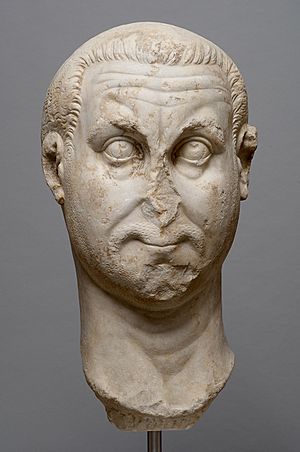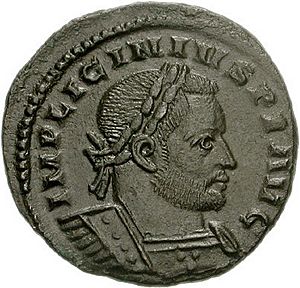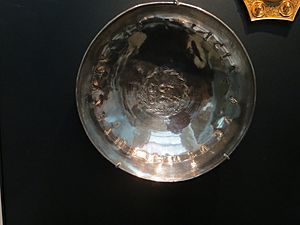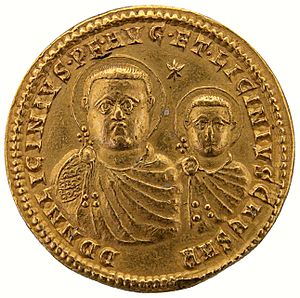Licinius facts for kids
Quick facts for kids Licinius |
|||||
|---|---|---|---|---|---|

Bust, Kunsthistorisches Museum
|
|||||
| Roman emperor | |||||
| Reign | 11 November 308 – 19 September 324 | ||||
| Predecessor | Severus II | ||||
| Successor | Constantine I (alone) | ||||
| Alongside | Galerius (East, 308–311) Constantine I (West, 308–324) Maximinus Daza (311–313) Valerius Valens (316–317) Martinianus (324) |
||||
| Born | Licinius Licinianus (?) c. 265 Moesia Superior, Roman Empire |
||||
| Died | Spring of 325 (aged around 60) Thessalonica |
||||
| Spouse | Flavia Julia Constantia | ||||
| Issue | Licinius II | ||||
|
|||||
| Religion | Ancient Roman religion | ||||
Valerius Licinianus Licinius (born around 265 – died 325) was a Roman emperor who ruled from 308 to 324 AD. For most of his time as emperor, he shared power with and was a rival of Constantine I. Together, they created the Edict of Milan in 313 AD. This important document officially allowed Christians to practice their religion freely in the Roman Empire. Licinius was eventually defeated by Constantine I at the Battle of Chrysopolis in 324 AD. He later died on Constantine's orders.
Contents
Becoming Emperor
Licinius was born into a farming family in a Roman province called Moesia Superior. He was a close friend of Galerius, who would also become an emperor. Licinius even joined Galerius on a trip to Persia in 298 AD.
Galerius trusted Licinius a lot. In 307 AD, he sent Licinius to Maxentius in Italy to try and make a deal about Maxentius's power. After the death of Severus II, Galerius gave Licinius control of the eastern provinces.
On November 11, 308 AD, Galerius made Licinius an Augustus in the West. An Augustus was a senior emperor. Licinius was put in charge of the Balkan provinces, including Illyricum, Thrace, and Pannonia. In 310 AD, he led a war against the Sarmatians and won a big victory.
When Galerius died in May 311 AD, Licinius made an agreement with Maximinus Daza to share the eastern provinces. Licinius controlled the European parts, and Maximinus took the Asian parts.
The Edict of Milan
An alliance between Maximinus Daza and Maxentius made Licinius and Constantine I form their own agreement. In March 313 AD, Licinius married Flavia Julia Constantia in Milan. She was Constantine I's half-sister. They had a son named Licinius the Younger in 315 AD.
Their marriage was a chance to issue the "Edict of Milan" together. This edict built on an earlier one by Galerius. It allowed Christianity and any other religion to be practiced freely in the Empire. It also ordered that property taken from Christian groups be returned. Christian clergy (religious leaders) were also excused from certain city duties. The edict used neutral language, saying it wanted to please "any Divinity whatsoever in the seat of the heavens."

Maximinus Daza decided to attack Licinius. He marched his army from Syria to Bithynia, but bad weather weakened his forces. In April 313 AD, he crossed into Europe and captured Byzantium after an eleven-day siege. He then took Heraclea.
Licinius arrived with a smaller army. Before a major battle, Licinius reportedly had a vision where an angel told him a prayer. He then shared this prayer with his soldiers. On April 30, 313 AD, the two armies fought at the Battle of Tzirallum. Daza's army was defeated. Daza tried to escape by disguising himself as a slave and fled to Nicomedia. He tried to stop Licinius's advance at the Cilician Gates but failed. Licinius continued to pursue him. The war ended when Daza died in August 313 AD.
Since Constantine had already defeated his rival Maxentius in 312 AD, Licinius and Constantine decided to divide the Roman world between them. This meant the old system of four rulers (the Tetrarchy) was replaced by two emperors, called Augusti. Licinius became the Augustus of the East, and Constantine became the Augustus of the West.
After this agreement, Licinius quickly went to the East to deal with an invasion by the Persian Sassanid Empire.
Conflicts with Constantine
In 314 AD, a civil war started between Licinius and Constantine. Constantine claimed that Licinius was helping someone who was plotting against him. Constantine won a battle at Cibalae in Pannonia on October 8, 314 AD.
Even though they shared the title of consul in 315 AD, the peace did not last long. A new war began the next year when Licinius made Valerius Valens a co-emperor. However, Licinius suffered a big defeat at the Battle of Mardia in Thrace. After these two battles, the emperors made peace, and Licinius had Valens killed.
For the next ten years, the two emperors had an uneasy peace. Licinius fought against the Sarmatians in 318 AD. But tensions rose again in 321 AD when Constantine chased some Sarmatians, who had raided his land, across the Danube River into Licinius's territory. When Constantine did this again with an invasion by the Goths, Licinius complained that Constantine had broken their treaty.
Constantine then went on the attack. Licinius's fleet of 350 ships was defeated by Constantine's fleet in 323 AD. In 324 AD, Constantine declared war again. He defeated Licinius's army at the Battle of Adrianople on July 3, 324 AD. Licinius was forced to retreat inside the walls of Byzantium.
Constantine's eldest son, Crispus, who was a Caesar, defeated Licinius's larger fleet in the Battle of Hellespont. This forced Licinius to move to Bithynia. The final battle, the Battle of Chrysopolis, happened near Chalcedon on September 18. Licinius was completely defeated.
Licinius and his co-emperor Martinian were initially spared due to the help of Flavia Julia Constantia, Constantine's sister and Licinius's wife. Licinius was imprisoned in Thessalonica, and Martinian in Cappadocia. However, both former emperors were later put to death. Licinius tried to regain power with the help of the Goths, but his plans were discovered. He was captured in Thessalonica and died.
Character and Legacy

After Licinius's death, Constantine tried to make him seem like a bad ruler. He said Licinius supported pagan gods. However, historical evidence suggests Licinius was a strong supporter of Christians at one point. He helped write the Edict of Milan, which ended the Great Persecution of Christians. He also confirmed the rights of Christians in his part of the empire. He even added a Christian symbol to his armies. His wife was a devoted Christian.
Some historians think he might have even converted to Christianity. However, Eusebius, who wrote during Constantine's rule, claimed that Licinius later expelled Christians from his palace and ordered sacrifices to pagan gods. It is thought that he supported Christians with Constantine at first, but later in his life, he may have turned against them and favored paganism.
After Licinius died, his public image was ruined. His statues were pulled down, and all his laws and court decisions were canceled by official order. This act of erasing someone from public memory is called damnatio memoriae.
See also
 In Spanish: Licinio para niños
In Spanish: Licinio para niños


